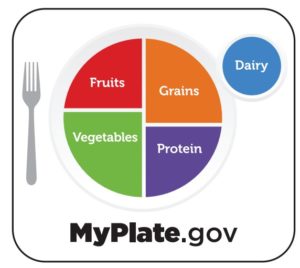Start with small changes: Fruits and vegetables
Note: This post is written by the team of The ONE Group (Oncology – Nutrition – Exercise) at Penn State College of Medicine as part of a first-person blog about their work. Learn more about the group here.
Is one of your resolutions to eat more healthfully? This is a great goal because a healthy diet can help you to improve medical conditions, to lose weight, or to just feel better. But making big changes to your diet can be challenging. This year why not start with small changes such as making at least half of your plate fruits and vegetables?
 Just eating more fruits and vegetables alone can help improve many health conditions including cardiovascular disease, high blood pressure, high cholesterol, diabetes and even some cancers. While using MyPlate as a guide, try to include a fruit, a vegetable, or both at every meal, every day with a goal of eating least 5 per day. By making the small goal of adding fruits and vegetables to the meals that you already eat, you will make big gains in your health.
Just eating more fruits and vegetables alone can help improve many health conditions including cardiovascular disease, high blood pressure, high cholesterol, diabetes and even some cancers. While using MyPlate as a guide, try to include a fruit, a vegetable, or both at every meal, every day with a goal of eating least 5 per day. By making the small goal of adding fruits and vegetables to the meals that you already eat, you will make big gains in your health.
Below are some tips for budget friendly ways to incorporate more fruits and vegetables into your everyday meals:
1. All forms count: Frozen, fresh, dried, and canned fruits and vegetables are all great options for snacks and meals. Rinse canned veggies under water to reduce the sodium and use them just like you would use fresh ones. Limit added sugars by looking for fruits canned in their own juice.
2. Dried or canned beans count: Beans are not only a vegetable, but they are also a great source of protein, fiber, other nutrients! These filling and satisfying veggies can be added to soups, stews, salads, tacos, wraps, or just about anything you can imagine. They also make a great meat substitute in any of your favorite winter comfort casseroles.
3. Think fruits and veggies first: When planning your meals, first identify the fruits and vegetables you like then plan a meal around them. Think peppers, onions, and beans with fajitas, tomatoes, peppers, and eggplant with pasta, cabbage, peas, and carrots with hearty soups, or green beans, edamame, and snow peas with stir fries.
4. Smoothies pack a punch: For a big boost blend frozen fruit with low-fat yogurt, milk, or milk-substitute for a healthy smoothie. Maybe even add some frozen kale or spinach for an extra added punch of veggies.
5. Top it all off with fruits and veggies: Topping or filling your everyday meals with fruits and veggies is an easy way to them in to foods you already like. Think toppings on pizza (peppers, mushrooms, onions, spinach, pineapple), breakfast cereal (strawberries, apples, blueberries, cherries), and eggs or baked potatoes (broccoli, vegetable chili, sautéed peppers and onions).
6. Fill it with veggies: When making wraps or sandwiches, don’t miss the opportunity to fill them with your favorite fillings or spreads. Think lettuce, peppers, spinach, cucumbers, tomatoes for toppings and hummus, pesto as a spread in place of mayonnaise or butter.
7. Remember the small goal: Include a fruit, a vegetable, or both at every meal, every day. For more tips, resources, and healthy recipes, visit the United States Department of Agriculture (USDA) MyPlate website.
More from The ONE Group
- The ONE Group (Oncology – Nutrition – Exercise)
- Exercise videos
- Patient guides
- Current research projects and studies
- Educational opportunities in exercise oncology
- Resources for inspiration
- Latest news
- The ONE Group blog
- Email ONEGroup@phs.psu.edu
If you're having trouble accessing this content, or would like it in another format, please email the Penn State College of Medicine web department.
